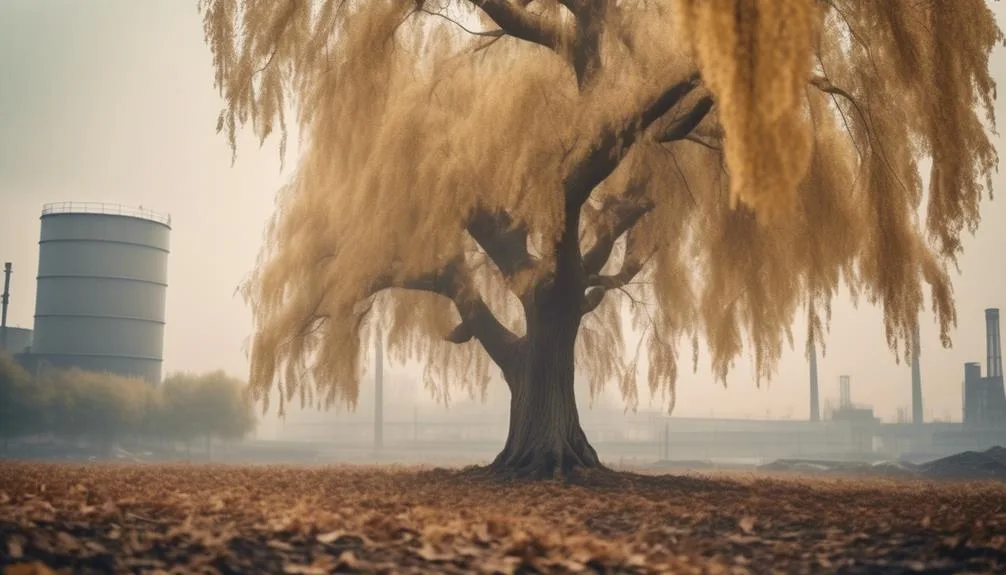Elm trees, often seen as tough and resistant, can actually suffer from air pollution. The impact of this pollution on elm trees is a critical issue, raising concerns about their health and endurance. Recognizing the signs of damage and potential long-term effects is vital.
Understanding the relationship between air pollution and elm trees is crucial for their well-being. Exploring the potential effects of air pollution on these trees reveals important considerations and necessary actions.
Impact of Air Pollution on Elm Trees
Air pollution poses a significant threat to the health and vitality of elm trees, impacting their growth and overall well-being.
The composition of soil crucially affects the ability of elm trees to withstand the harmful effects of air pollution. When soil becomes contaminated due to pollutants, it can hinder the tree's ability to absorb necessary nutrients, leading to stunted growth and weakened resilience against diseases.
In addition, air pollution can exacerbate insect infestations, further endangering the well-being of elm trees. Pollutants in the air can attract destructive pests, making the trees more susceptible to infestations and diseases.
As a result, the overall health and longevity of elm trees are significantly compromised by the detrimental effects of air pollution, emphasizing the urgent need for measures to mitigate this environmental threat.
Signs of Air Pollution Damage on Elm Trees
When assessing the impact of air pollution on elm trees, discernible signs of damage may include:
- Leaf discoloration, often manifested as yellowing or bronzing, which is a common indicator of air pollution damage.
- Stunted growth, where trees exhibit reduced height or crown density compared to their expected growth patterns, can be attributed to air pollution effects.
- Increased susceptibility to pest infestations is another sign of air pollution damage, as weakened trees are more vulnerable to attacks from pests and diseases.
To accurately assess the extent of damage, environmental monitoring and damage assessment are crucial. Regular monitoring helps in identifying early signs of damage, allowing for timely intervention to mitigate further harm to the elm trees.
Measures to Protect Elm Trees From Air Pollution
Protecting elm trees from air pollution requires implementing proactive measures to maintain their health and resilience, safeguarding them from the detrimental effects of environmental contaminants. It's crucial to take protective measures to mitigate the environmental impact on these majestic trees. Here are some effective strategies to shield elm trees from air pollution:
| Protective Measure | Description |
|---|---|
| Planting Barrier Hedges | Creating a barrier of dense hedges around elm trees can help reduce the impact of air pollution by trapping particulate matter and absorbing harmful gases. |
| Regular Pruning and Maintenance | Keeping elm trees healthy and vigorous through regular pruning and maintenance can enhance their ability to withstand the effects of air pollution. |
| Mulching | Applying a layer of mulch around the base of elm trees helps in reducing soil compaction and enhancing their resistance to air pollution. |
| Monitoring Air Quality | Regular monitoring of air quality in the vicinity of elm trees can aid in identifying potential threats and taking timely preventive actions. |
Elm Tree Varieties Resilient to Air Pollution
Resilient elm tree varieties offer a promising solution for maintaining tree health in urban environments with high levels of air pollution. Certain elm species, such as the Princeton and Valley Forge varieties, have shown remarkable resistance to air pollution. These resistant species have developed environmental adaptations that enable them to withstand the harmful effects of pollutants like sulfur dioxide and ozone. Their ability to tolerate these pollutants makes them ideal choices for planting in areas with poor air quality.
In addition to these naturally resistant species, the Resista® Elm series has been specifically bred for their resilience to Dutch elm disease and air pollution. This series includes varieties like New Harmony and Patriot. Planting these resilient elm tree varieties not only helps combat air pollution but also ensures the longevity and health of urban tree populations.
Importance of Addressing Air Pollution for Elm Trees
Addressing air pollution is crucial for the health and longevity of elm trees, as it directly impacts their ability to thrive in urban environments. Urban forestry plays a significant role in maintaining the environmental impact of elm trees.
Air pollution can cause leaf damage, stunted growth, and increased susceptibility to diseases in these majestic trees. Pollution control measures are essential to safeguard the well-being of elm trees, ensuring they continue to provide their numerous ecological benefits.
By addressing air pollution, you contribute to the overall health of urban forests, preserving the beauty and functionality of elm trees within our cities. These trees not only enhance the aesthetic appeal of urban landscapes but also provide vital ecosystem services such as air purification and wildlife habitat.
Prioritizing pollution control is paramount for the sustainability of elm trees and the urban environments they inhabit.
Conclusion
In preserving the health of elm trees, addressing air pollution is essential.
By recognizing the impact of pollution and implementing protective measures, we can safeguard the resilience and beauty of these trees for the future.

My interest in trees started when I first saw the giant sequoias in Yosemite.
I was a teenager then, and I remember thinking, “I need to learn more about this.”
That moment stuck with me.
A few years later, I went on to study forestry at Michigan Tech.
Since graduating, I’ve worked in a mix of hands-on tree care and community education.
I’ve spent over ten years helping people understand how to plant, maintain, and protect the trees in their neighborhoods.
I don’t see trees as just part of the landscape.
They are living things that make a real difference in our daily lives.
